Human Factors in Systems Design: Usability of an EHR System (IMAT5209)
VerifiedAdded on 2023/02/01
|19
|5596
|66
Report
AI Summary
This report presents a comprehensive analysis of an Electronic Health Record (EHR) system, focusing on human factors in its design and usability. The report begins by defining interactive systems and their applications, specifically highlighting the use of EHR systems in healthcare for recording, retrieving, and monitoring patient data. It then outlines the various use cases of the EHR system, particularly within the laboratory setting, detailing the steps involved in locating data, contacting responders, validating credentials, verifying patient identity, finding results, authorizing data release, reviewing results, verifying receipt, and logging transactions. The core of the report delves into the usability requirements of the EHR system, emphasizing the importance of performance, user-friendliness, error tolerance, flow, and productivity. It also describes the cognitive walkthrough evaluation methodology used, including the selection of users, definition of goals, task performance, and questioning of users to identify usability issues. The evaluation section summarizes the findings, noting the successes and challenges encountered by users during registration, login, patient data recording, and data retrieval. The report concludes by highlighting the significance of the evaluation methodology in assessing the system's effectiveness and identifying areas for improvement to enhance user experience and system efficiency.
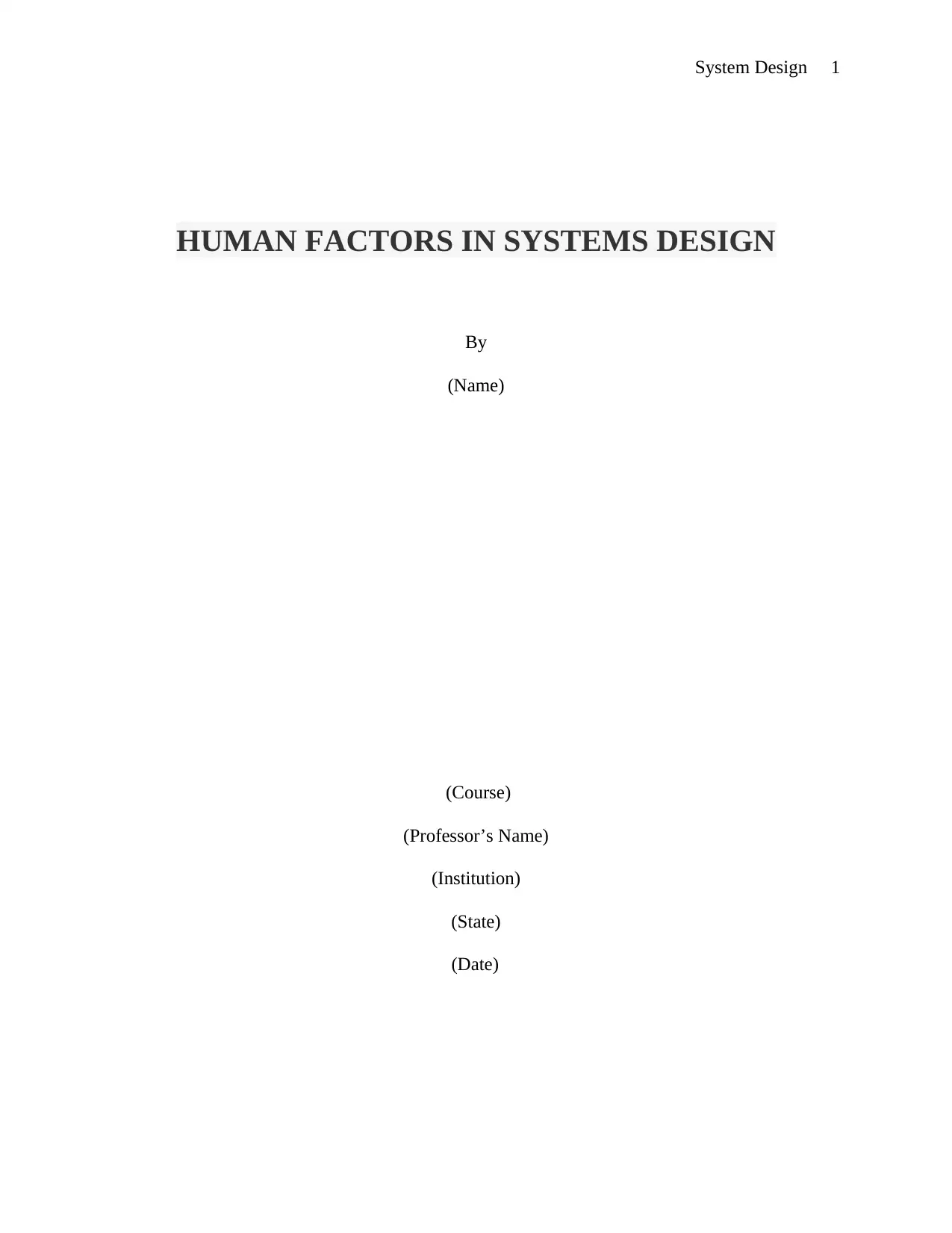
System Design 1
HUMAN FACTORS IN SYSTEMS DESIGN
By
(Name)
(Course)
(Professor’s Name)
(Institution)
(State)
(Date)
HUMAN FACTORS IN SYSTEMS DESIGN
By
(Name)
(Course)
(Professor’s Name)
(Institution)
(State)
(Date)
Paraphrase This Document
Need a fresh take? Get an instant paraphrase of this document with our AI Paraphraser
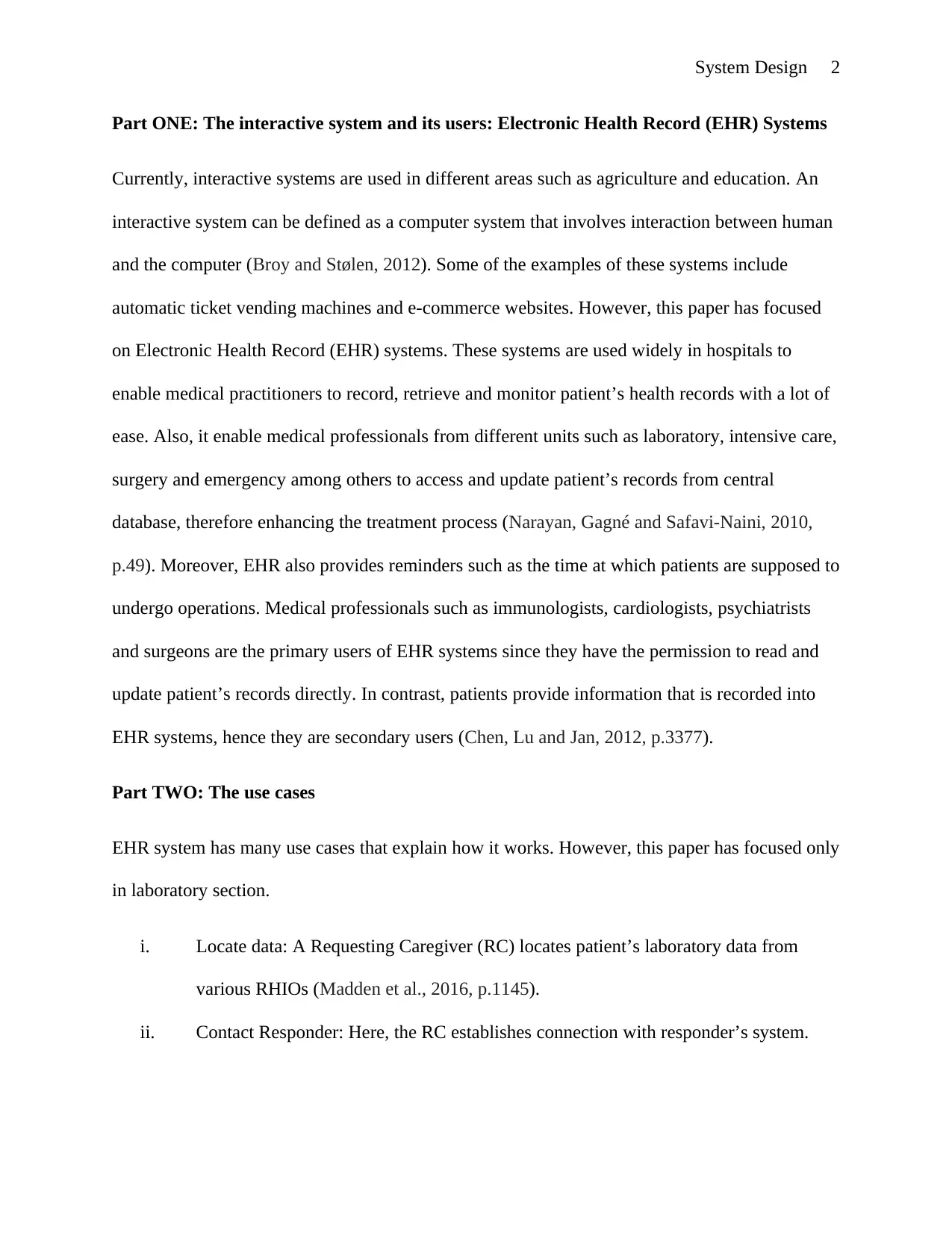
System Design 2
Part ONE: The interactive system and its users: Electronic Health Record (EHR) Systems
Currently, interactive systems are used in different areas such as agriculture and education. An
interactive system can be defined as a computer system that involves interaction between human
and the computer (Broy and Stølen, 2012). Some of the examples of these systems include
automatic ticket vending machines and e-commerce websites. However, this paper has focused
on Electronic Health Record (EHR) systems. These systems are used widely in hospitals to
enable medical practitioners to record, retrieve and monitor patient’s health records with a lot of
ease. Also, it enable medical professionals from different units such as laboratory, intensive care,
surgery and emergency among others to access and update patient’s records from central
database, therefore enhancing the treatment process (Narayan, Gagné and Safavi-Naini, 2010,
p.49). Moreover, EHR also provides reminders such as the time at which patients are supposed to
undergo operations. Medical professionals such as immunologists, cardiologists, psychiatrists
and surgeons are the primary users of EHR systems since they have the permission to read and
update patient’s records directly. In contrast, patients provide information that is recorded into
EHR systems, hence they are secondary users (Chen, Lu and Jan, 2012, p.3377).
Part TWO: The use cases
EHR system has many use cases that explain how it works. However, this paper has focused only
in laboratory section.
i. Locate data: A Requesting Caregiver (RC) locates patient’s laboratory data from
various RHIOs (Madden et al., 2016, p.1145).
ii. Contact Responder: Here, the RC establishes connection with responder’s system.
Part ONE: The interactive system and its users: Electronic Health Record (EHR) Systems
Currently, interactive systems are used in different areas such as agriculture and education. An
interactive system can be defined as a computer system that involves interaction between human
and the computer (Broy and Stølen, 2012). Some of the examples of these systems include
automatic ticket vending machines and e-commerce websites. However, this paper has focused
on Electronic Health Record (EHR) systems. These systems are used widely in hospitals to
enable medical practitioners to record, retrieve and monitor patient’s health records with a lot of
ease. Also, it enable medical professionals from different units such as laboratory, intensive care,
surgery and emergency among others to access and update patient’s records from central
database, therefore enhancing the treatment process (Narayan, Gagné and Safavi-Naini, 2010,
p.49). Moreover, EHR also provides reminders such as the time at which patients are supposed to
undergo operations. Medical professionals such as immunologists, cardiologists, psychiatrists
and surgeons are the primary users of EHR systems since they have the permission to read and
update patient’s records directly. In contrast, patients provide information that is recorded into
EHR systems, hence they are secondary users (Chen, Lu and Jan, 2012, p.3377).
Part TWO: The use cases
EHR system has many use cases that explain how it works. However, this paper has focused only
in laboratory section.
i. Locate data: A Requesting Caregiver (RC) locates patient’s laboratory data from
various RHIOs (Madden et al., 2016, p.1145).
ii. Contact Responder: Here, the RC establishes connection with responder’s system.
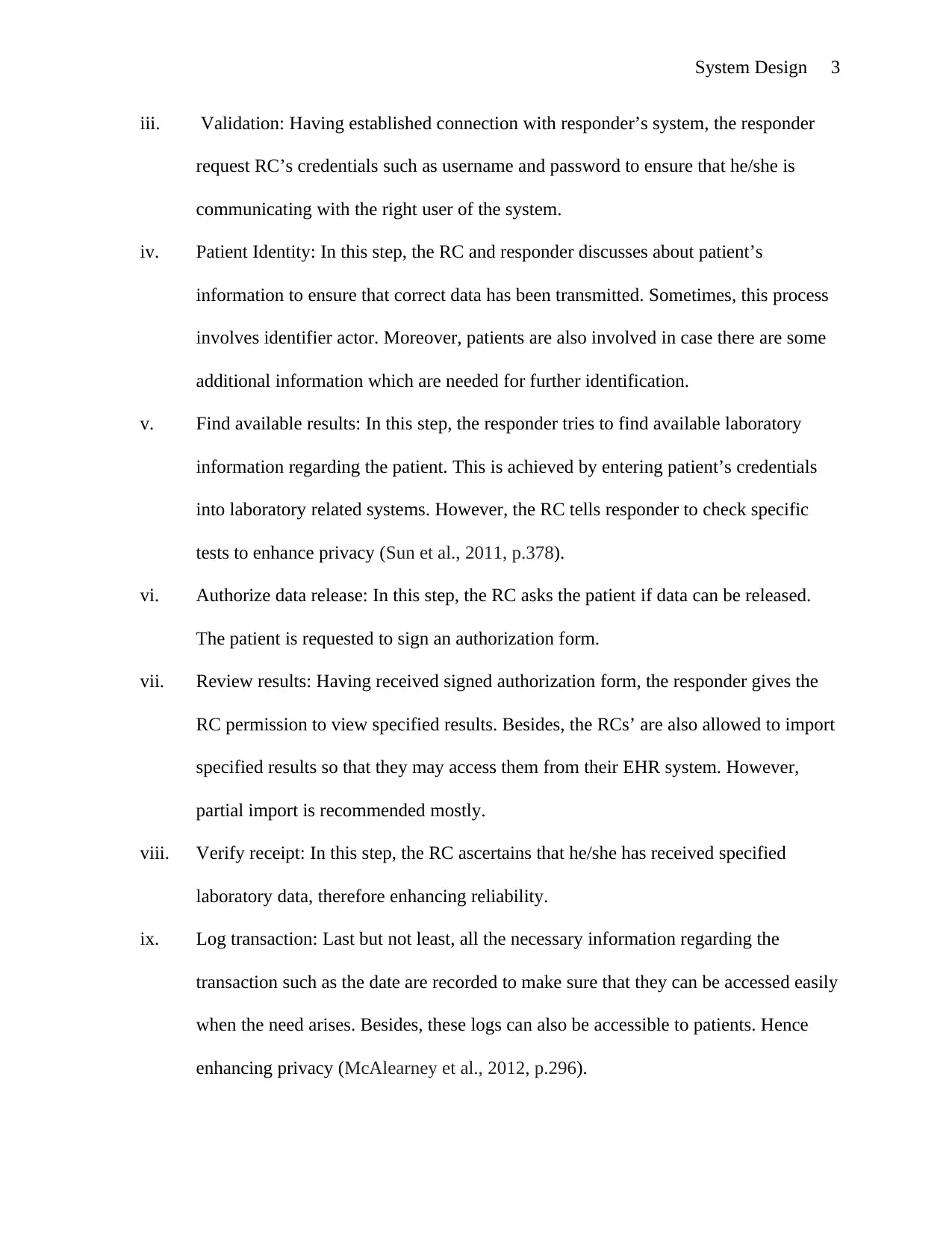
System Design 3
iii. Validation: Having established connection with responder’s system, the responder
request RC’s credentials such as username and password to ensure that he/she is
communicating with the right user of the system.
iv. Patient Identity: In this step, the RC and responder discusses about patient’s
information to ensure that correct data has been transmitted. Sometimes, this process
involves identifier actor. Moreover, patients are also involved in case there are some
additional information which are needed for further identification.
v. Find available results: In this step, the responder tries to find available laboratory
information regarding the patient. This is achieved by entering patient’s credentials
into laboratory related systems. However, the RC tells responder to check specific
tests to enhance privacy (Sun et al., 2011, p.378).
vi. Authorize data release: In this step, the RC asks the patient if data can be released.
The patient is requested to sign an authorization form.
vii. Review results: Having received signed authorization form, the responder gives the
RC permission to view specified results. Besides, the RCs’ are also allowed to import
specified results so that they may access them from their EHR system. However,
partial import is recommended mostly.
viii. Verify receipt: In this step, the RC ascertains that he/she has received specified
laboratory data, therefore enhancing reliability.
ix. Log transaction: Last but not least, all the necessary information regarding the
transaction such as the date are recorded to make sure that they can be accessed easily
when the need arises. Besides, these logs can also be accessible to patients. Hence
enhancing privacy (McAlearney et al., 2012, p.296).
iii. Validation: Having established connection with responder’s system, the responder
request RC’s credentials such as username and password to ensure that he/she is
communicating with the right user of the system.
iv. Patient Identity: In this step, the RC and responder discusses about patient’s
information to ensure that correct data has been transmitted. Sometimes, this process
involves identifier actor. Moreover, patients are also involved in case there are some
additional information which are needed for further identification.
v. Find available results: In this step, the responder tries to find available laboratory
information regarding the patient. This is achieved by entering patient’s credentials
into laboratory related systems. However, the RC tells responder to check specific
tests to enhance privacy (Sun et al., 2011, p.378).
vi. Authorize data release: In this step, the RC asks the patient if data can be released.
The patient is requested to sign an authorization form.
vii. Review results: Having received signed authorization form, the responder gives the
RC permission to view specified results. Besides, the RCs’ are also allowed to import
specified results so that they may access them from their EHR system. However,
partial import is recommended mostly.
viii. Verify receipt: In this step, the RC ascertains that he/she has received specified
laboratory data, therefore enhancing reliability.
ix. Log transaction: Last but not least, all the necessary information regarding the
transaction such as the date are recorded to make sure that they can be accessed easily
when the need arises. Besides, these logs can also be accessible to patients. Hence
enhancing privacy (McAlearney et al., 2012, p.296).
⊘ This is a preview!⊘
Do you want full access?
Subscribe today to unlock all pages.

Trusted by 1+ million students worldwide
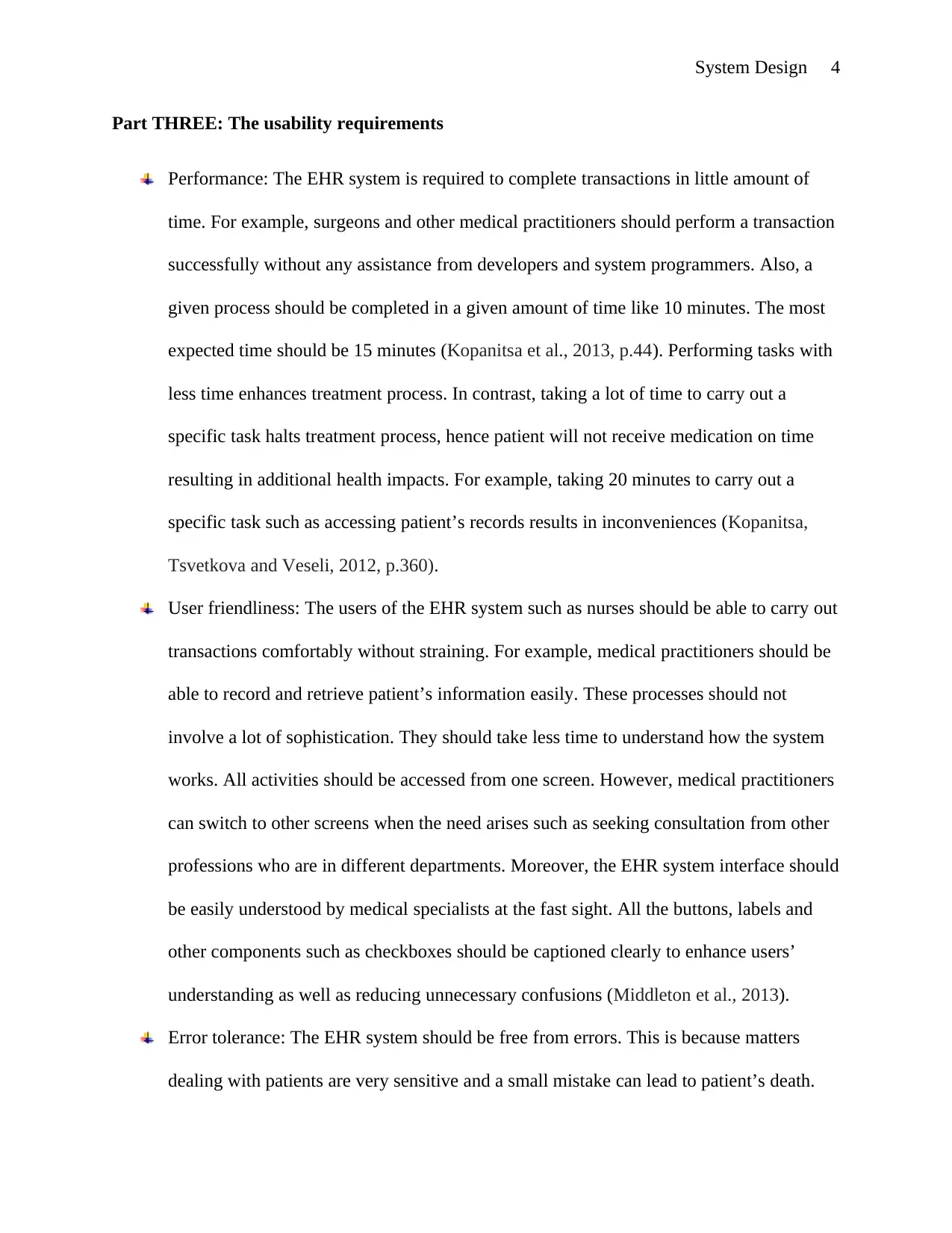
System Design 4
Part THREE: The usability requirements
Performance: The EHR system is required to complete transactions in little amount of
time. For example, surgeons and other medical practitioners should perform a transaction
successfully without any assistance from developers and system programmers. Also, a
given process should be completed in a given amount of time like 10 minutes. The most
expected time should be 15 minutes (Kopanitsa et al., 2013, p.44). Performing tasks with
less time enhances treatment process. In contrast, taking a lot of time to carry out a
specific task halts treatment process, hence patient will not receive medication on time
resulting in additional health impacts. For example, taking 20 minutes to carry out a
specific task such as accessing patient’s records results in inconveniences (Kopanitsa,
Tsvetkova and Veseli, 2012, p.360).
User friendliness: The users of the EHR system such as nurses should be able to carry out
transactions comfortably without straining. For example, medical practitioners should be
able to record and retrieve patient’s information easily. These processes should not
involve a lot of sophistication. They should take less time to understand how the system
works. All activities should be accessed from one screen. However, medical practitioners
can switch to other screens when the need arises such as seeking consultation from other
professions who are in different departments. Moreover, the EHR system interface should
be easily understood by medical specialists at the fast sight. All the buttons, labels and
other components such as checkboxes should be captioned clearly to enhance users’
understanding as well as reducing unnecessary confusions (Middleton et al., 2013).
Error tolerance: The EHR system should be free from errors. This is because matters
dealing with patients are very sensitive and a small mistake can lead to patient’s death.
Part THREE: The usability requirements
Performance: The EHR system is required to complete transactions in little amount of
time. For example, surgeons and other medical practitioners should perform a transaction
successfully without any assistance from developers and system programmers. Also, a
given process should be completed in a given amount of time like 10 minutes. The most
expected time should be 15 minutes (Kopanitsa et al., 2013, p.44). Performing tasks with
less time enhances treatment process. In contrast, taking a lot of time to carry out a
specific task halts treatment process, hence patient will not receive medication on time
resulting in additional health impacts. For example, taking 20 minutes to carry out a
specific task such as accessing patient’s records results in inconveniences (Kopanitsa,
Tsvetkova and Veseli, 2012, p.360).
User friendliness: The users of the EHR system such as nurses should be able to carry out
transactions comfortably without straining. For example, medical practitioners should be
able to record and retrieve patient’s information easily. These processes should not
involve a lot of sophistication. They should take less time to understand how the system
works. All activities should be accessed from one screen. However, medical practitioners
can switch to other screens when the need arises such as seeking consultation from other
professions who are in different departments. Moreover, the EHR system interface should
be easily understood by medical specialists at the fast sight. All the buttons, labels and
other components such as checkboxes should be captioned clearly to enhance users’
understanding as well as reducing unnecessary confusions (Middleton et al., 2013).
Error tolerance: The EHR system should be free from errors. This is because matters
dealing with patients are very sensitive and a small mistake can lead to patient’s death.
Paraphrase This Document
Need a fresh take? Get an instant paraphrase of this document with our AI Paraphraser
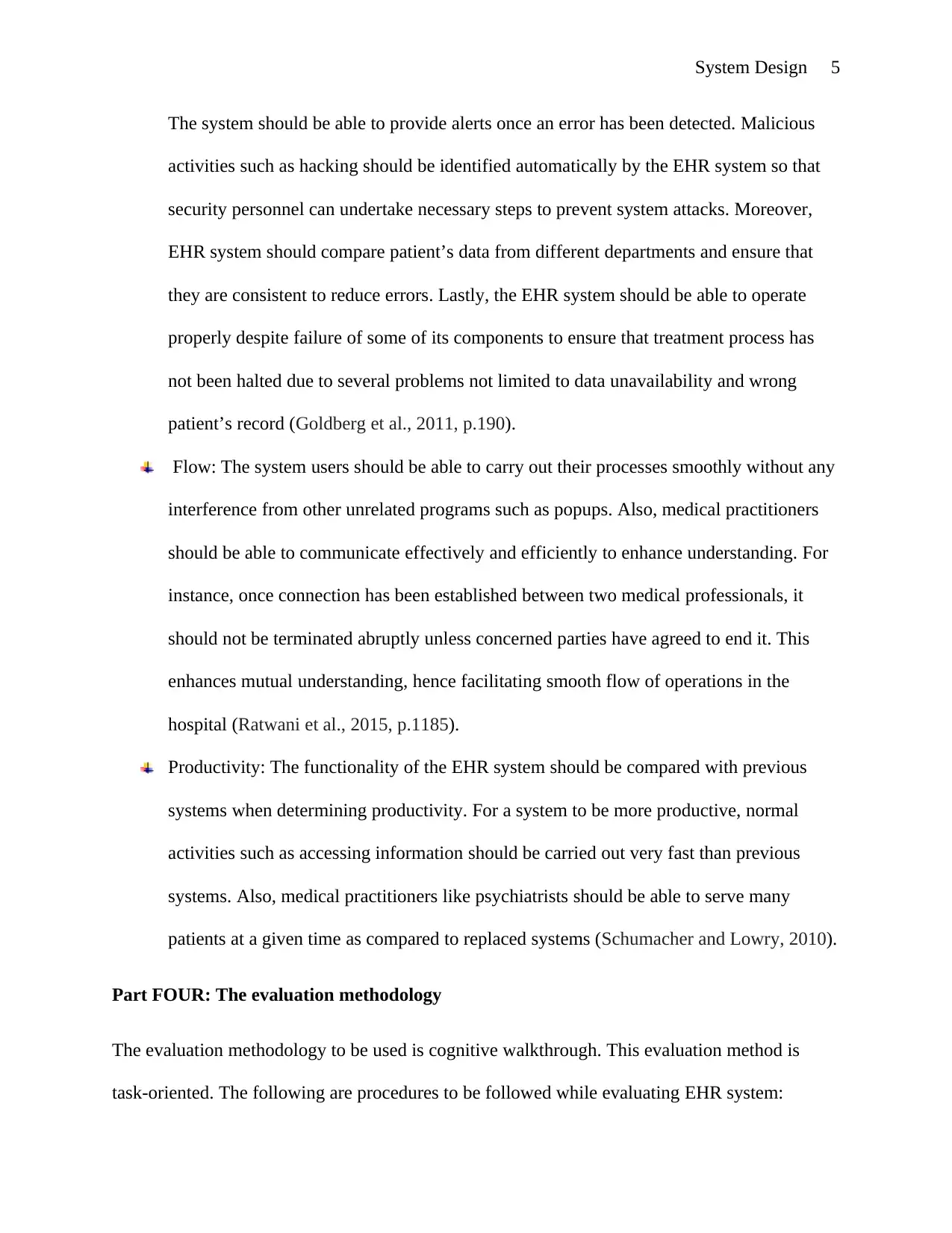
System Design 5
The system should be able to provide alerts once an error has been detected. Malicious
activities such as hacking should be identified automatically by the EHR system so that
security personnel can undertake necessary steps to prevent system attacks. Moreover,
EHR system should compare patient’s data from different departments and ensure that
they are consistent to reduce errors. Lastly, the EHR system should be able to operate
properly despite failure of some of its components to ensure that treatment process has
not been halted due to several problems not limited to data unavailability and wrong
patient’s record (Goldberg et al., 2011, p.190).
Flow: The system users should be able to carry out their processes smoothly without any
interference from other unrelated programs such as popups. Also, medical practitioners
should be able to communicate effectively and efficiently to enhance understanding. For
instance, once connection has been established between two medical professionals, it
should not be terminated abruptly unless concerned parties have agreed to end it. This
enhances mutual understanding, hence facilitating smooth flow of operations in the
hospital (Ratwani et al., 2015, p.1185).
Productivity: The functionality of the EHR system should be compared with previous
systems when determining productivity. For a system to be more productive, normal
activities such as accessing information should be carried out very fast than previous
systems. Also, medical practitioners like psychiatrists should be able to serve many
patients at a given time as compared to replaced systems (Schumacher and Lowry, 2010).
Part FOUR: The evaluation methodology
The evaluation methodology to be used is cognitive walkthrough. This evaluation method is
task-oriented. The following are procedures to be followed while evaluating EHR system:
The system should be able to provide alerts once an error has been detected. Malicious
activities such as hacking should be identified automatically by the EHR system so that
security personnel can undertake necessary steps to prevent system attacks. Moreover,
EHR system should compare patient’s data from different departments and ensure that
they are consistent to reduce errors. Lastly, the EHR system should be able to operate
properly despite failure of some of its components to ensure that treatment process has
not been halted due to several problems not limited to data unavailability and wrong
patient’s record (Goldberg et al., 2011, p.190).
Flow: The system users should be able to carry out their processes smoothly without any
interference from other unrelated programs such as popups. Also, medical practitioners
should be able to communicate effectively and efficiently to enhance understanding. For
instance, once connection has been established between two medical professionals, it
should not be terminated abruptly unless concerned parties have agreed to end it. This
enhances mutual understanding, hence facilitating smooth flow of operations in the
hospital (Ratwani et al., 2015, p.1185).
Productivity: The functionality of the EHR system should be compared with previous
systems when determining productivity. For a system to be more productive, normal
activities such as accessing information should be carried out very fast than previous
systems. Also, medical practitioners like psychiatrists should be able to serve many
patients at a given time as compared to replaced systems (Schumacher and Lowry, 2010).
Part FOUR: The evaluation methodology
The evaluation methodology to be used is cognitive walkthrough. This evaluation method is
task-oriented. The following are procedures to be followed while evaluating EHR system:

System Design 6
i. Selecting users: In this step, patients and medical specialists who will take part in
EHR system evaluation are selected. However, not only experienced users are
selected, but also inexperienced (Saitwal et al., 2010, p.503).
ii. Define goals: The desired outcomes are explained explicitly. The following are some
of the questions that medical specialists are asked in this step:
a. Are you able to register and login successfully to the EHR system?
b. Are you able to enter and update patient’s data successfully?
c. Are you able to access patient’s records successfully?
The following are some of the goals of EHR system:
i. To reduce the time that is used for recording and accessing patient’s records
manually.
ii. To enhance quality of patient’s health information.
iii. To improve co-ordination between different units within the hospital
(Grabenbauer, Fruhling and Windle, 2014, p.2630).
iii. Perform the tasks: In this step, users are requested to carry out specific activities
using EHR system. Some of the tasks include:
a. Register to the EHR system by entering username, department and type of
medical specialist such as surgeon.
b. After registration, login by providing username and password.
c. Click patient registration button and register patients.
d. Access patient’s account and update his/her information related to diagnosis.
e. Request patient’s records from other units within the hospital such as emergency
and intensive care.
i. Selecting users: In this step, patients and medical specialists who will take part in
EHR system evaluation are selected. However, not only experienced users are
selected, but also inexperienced (Saitwal et al., 2010, p.503).
ii. Define goals: The desired outcomes are explained explicitly. The following are some
of the questions that medical specialists are asked in this step:
a. Are you able to register and login successfully to the EHR system?
b. Are you able to enter and update patient’s data successfully?
c. Are you able to access patient’s records successfully?
The following are some of the goals of EHR system:
i. To reduce the time that is used for recording and accessing patient’s records
manually.
ii. To enhance quality of patient’s health information.
iii. To improve co-ordination between different units within the hospital
(Grabenbauer, Fruhling and Windle, 2014, p.2630).
iii. Perform the tasks: In this step, users are requested to carry out specific activities
using EHR system. Some of the tasks include:
a. Register to the EHR system by entering username, department and type of
medical specialist such as surgeon.
b. After registration, login by providing username and password.
c. Click patient registration button and register patients.
d. Access patient’s account and update his/her information related to diagnosis.
e. Request patient’s records from other units within the hospital such as emergency
and intensive care.
⊘ This is a preview!⊘
Do you want full access?
Subscribe today to unlock all pages.

Trusted by 1+ million students worldwide
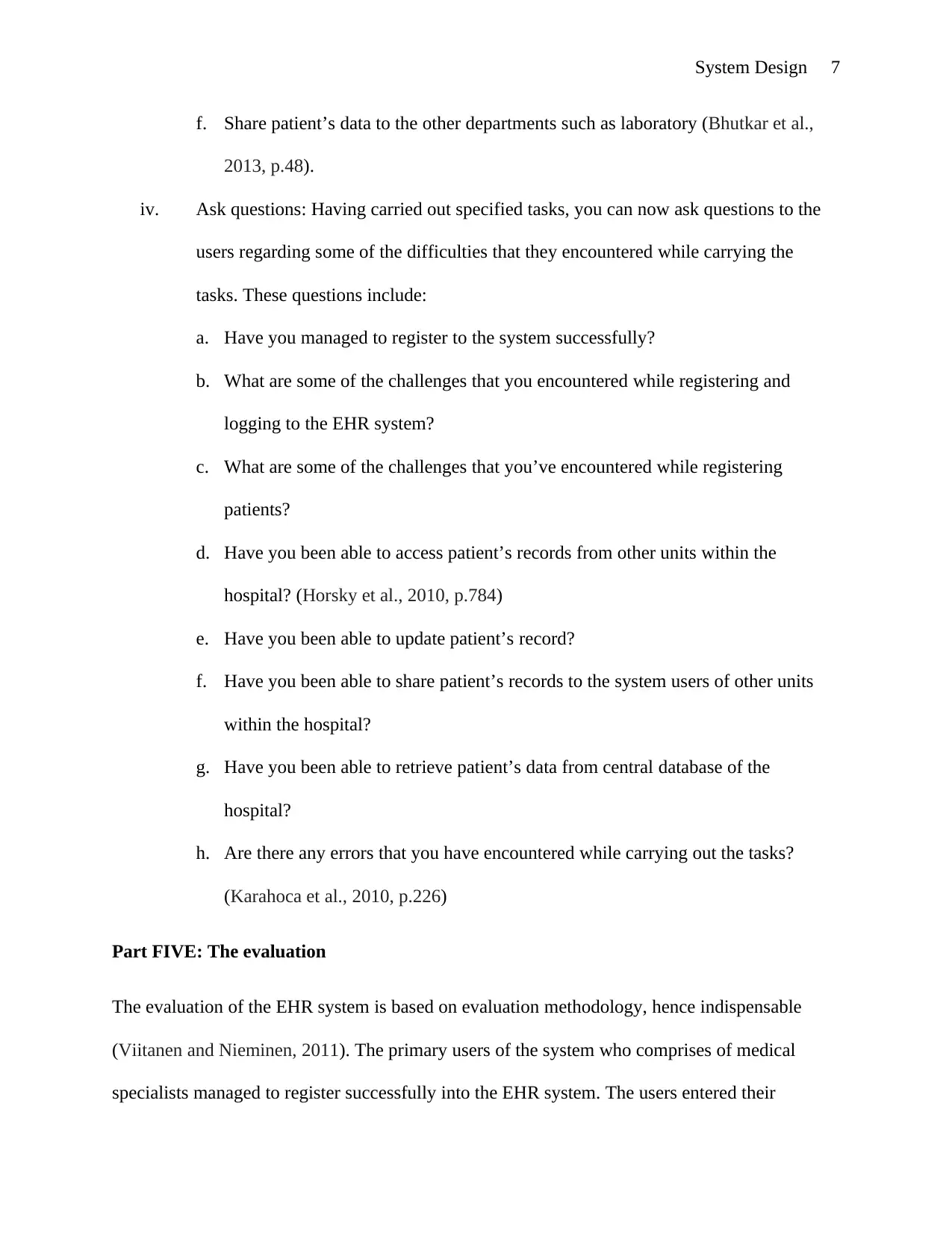
System Design 7
f. Share patient’s data to the other departments such as laboratory (Bhutkar et al.,
2013, p.48).
iv. Ask questions: Having carried out specified tasks, you can now ask questions to the
users regarding some of the difficulties that they encountered while carrying the
tasks. These questions include:
a. Have you managed to register to the system successfully?
b. What are some of the challenges that you encountered while registering and
logging to the EHR system?
c. What are some of the challenges that you’ve encountered while registering
patients?
d. Have you been able to access patient’s records from other units within the
hospital? (Horsky et al., 2010, p.784)
e. Have you been able to update patient’s record?
f. Have you been able to share patient’s records to the system users of other units
within the hospital?
g. Have you been able to retrieve patient’s data from central database of the
hospital?
h. Are there any errors that you have encountered while carrying out the tasks?
(Karahoca et al., 2010, p.226)
Part FIVE: The evaluation
The evaluation of the EHR system is based on evaluation methodology, hence indispensable
(Viitanen and Nieminen, 2011). The primary users of the system who comprises of medical
specialists managed to register successfully into the EHR system. The users entered their
f. Share patient’s data to the other departments such as laboratory (Bhutkar et al.,
2013, p.48).
iv. Ask questions: Having carried out specified tasks, you can now ask questions to the
users regarding some of the difficulties that they encountered while carrying the
tasks. These questions include:
a. Have you managed to register to the system successfully?
b. What are some of the challenges that you encountered while registering and
logging to the EHR system?
c. What are some of the challenges that you’ve encountered while registering
patients?
d. Have you been able to access patient’s records from other units within the
hospital? (Horsky et al., 2010, p.784)
e. Have you been able to update patient’s record?
f. Have you been able to share patient’s records to the system users of other units
within the hospital?
g. Have you been able to retrieve patient’s data from central database of the
hospital?
h. Are there any errors that you have encountered while carrying out the tasks?
(Karahoca et al., 2010, p.226)
Part FIVE: The evaluation
The evaluation of the EHR system is based on evaluation methodology, hence indispensable
(Viitanen and Nieminen, 2011). The primary users of the system who comprises of medical
specialists managed to register successfully into the EHR system. The users entered their
Paraphrase This Document
Need a fresh take? Get an instant paraphrase of this document with our AI Paraphraser
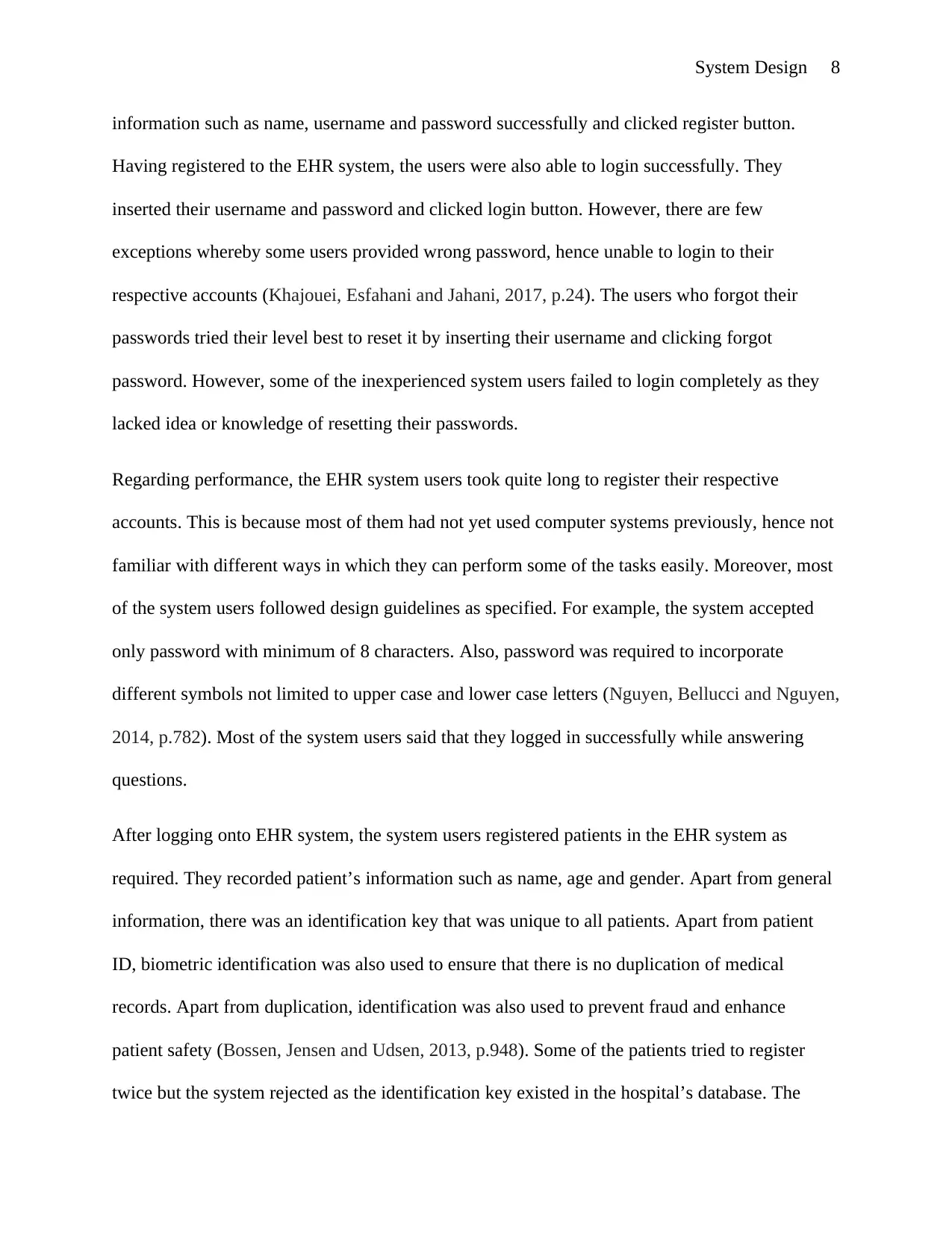
System Design 8
information such as name, username and password successfully and clicked register button.
Having registered to the EHR system, the users were also able to login successfully. They
inserted their username and password and clicked login button. However, there are few
exceptions whereby some users provided wrong password, hence unable to login to their
respective accounts (Khajouei, Esfahani and Jahani, 2017, p.24). The users who forgot their
passwords tried their level best to reset it by inserting their username and clicking forgot
password. However, some of the inexperienced system users failed to login completely as they
lacked idea or knowledge of resetting their passwords.
Regarding performance, the EHR system users took quite long to register their respective
accounts. This is because most of them had not yet used computer systems previously, hence not
familiar with different ways in which they can perform some of the tasks easily. Moreover, most
of the system users followed design guidelines as specified. For example, the system accepted
only password with minimum of 8 characters. Also, password was required to incorporate
different symbols not limited to upper case and lower case letters (Nguyen, Bellucci and Nguyen,
2014, p.782). Most of the system users said that they logged in successfully while answering
questions.
After logging onto EHR system, the system users registered patients in the EHR system as
required. They recorded patient’s information such as name, age and gender. Apart from general
information, there was an identification key that was unique to all patients. Apart from patient
ID, biometric identification was also used to ensure that there is no duplication of medical
records. Apart from duplication, identification was also used to prevent fraud and enhance
patient safety (Bossen, Jensen and Udsen, 2013, p.948). Some of the patients tried to register
twice but the system rejected as the identification key existed in the hospital’s database. The
information such as name, username and password successfully and clicked register button.
Having registered to the EHR system, the users were also able to login successfully. They
inserted their username and password and clicked login button. However, there are few
exceptions whereby some users provided wrong password, hence unable to login to their
respective accounts (Khajouei, Esfahani and Jahani, 2017, p.24). The users who forgot their
passwords tried their level best to reset it by inserting their username and clicking forgot
password. However, some of the inexperienced system users failed to login completely as they
lacked idea or knowledge of resetting their passwords.
Regarding performance, the EHR system users took quite long to register their respective
accounts. This is because most of them had not yet used computer systems previously, hence not
familiar with different ways in which they can perform some of the tasks easily. Moreover, most
of the system users followed design guidelines as specified. For example, the system accepted
only password with minimum of 8 characters. Also, password was required to incorporate
different symbols not limited to upper case and lower case letters (Nguyen, Bellucci and Nguyen,
2014, p.782). Most of the system users said that they logged in successfully while answering
questions.
After logging onto EHR system, the system users registered patients in the EHR system as
required. They recorded patient’s information such as name, age and gender. Apart from general
information, there was an identification key that was unique to all patients. Apart from patient
ID, biometric identification was also used to ensure that there is no duplication of medical
records. Apart from duplication, identification was also used to prevent fraud and enhance
patient safety (Bossen, Jensen and Udsen, 2013, p.948). Some of the patients tried to register
twice but the system rejected as the identification key existed in the hospital’s database. The
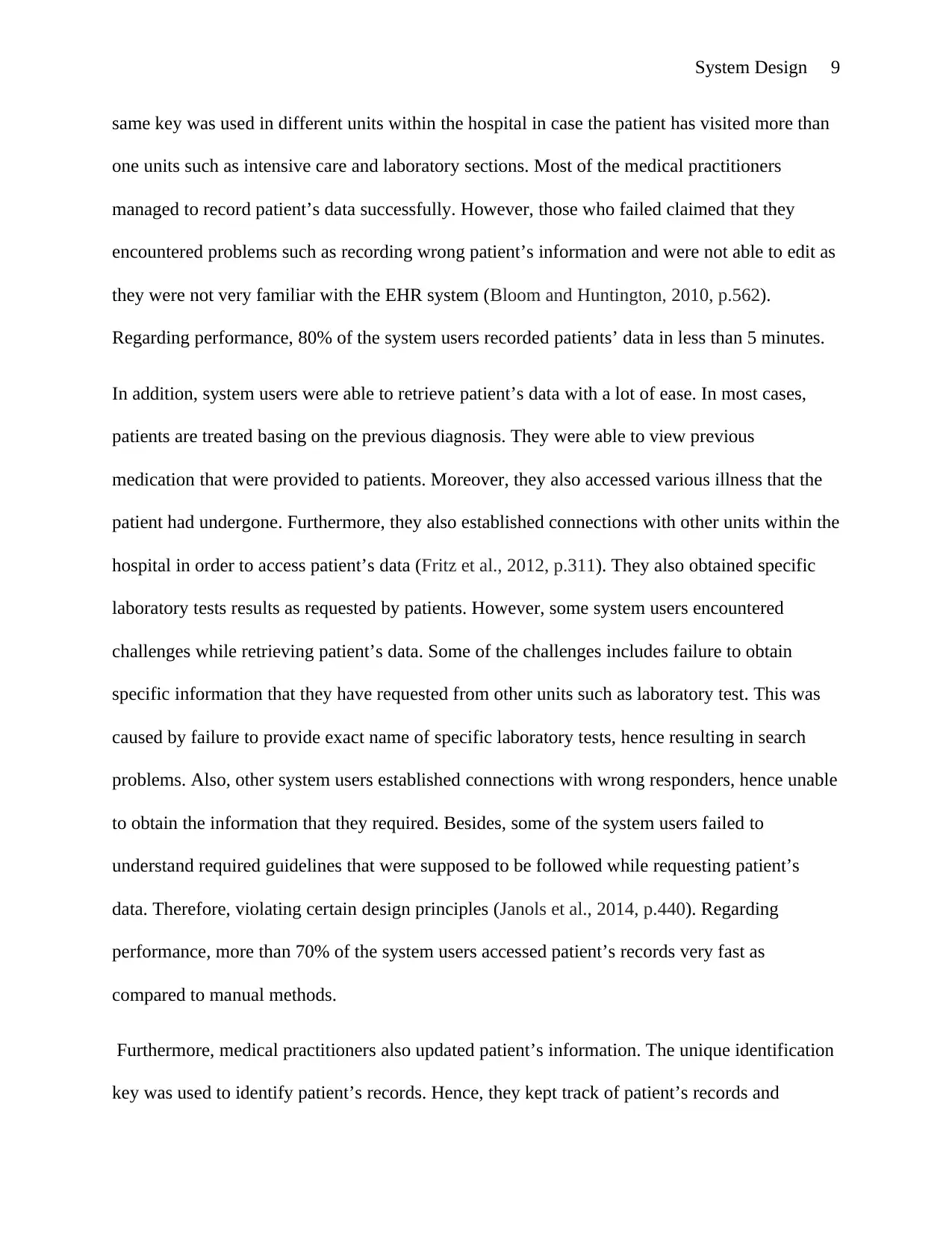
System Design 9
same key was used in different units within the hospital in case the patient has visited more than
one units such as intensive care and laboratory sections. Most of the medical practitioners
managed to record patient’s data successfully. However, those who failed claimed that they
encountered problems such as recording wrong patient’s information and were not able to edit as
they were not very familiar with the EHR system (Bloom and Huntington, 2010, p.562).
Regarding performance, 80% of the system users recorded patients’ data in less than 5 minutes.
In addition, system users were able to retrieve patient’s data with a lot of ease. In most cases,
patients are treated basing on the previous diagnosis. They were able to view previous
medication that were provided to patients. Moreover, they also accessed various illness that the
patient had undergone. Furthermore, they also established connections with other units within the
hospital in order to access patient’s data (Fritz et al., 2012, p.311). They also obtained specific
laboratory tests results as requested by patients. However, some system users encountered
challenges while retrieving patient’s data. Some of the challenges includes failure to obtain
specific information that they have requested from other units such as laboratory test. This was
caused by failure to provide exact name of specific laboratory tests, hence resulting in search
problems. Also, other system users established connections with wrong responders, hence unable
to obtain the information that they required. Besides, some of the system users failed to
understand required guidelines that were supposed to be followed while requesting patient’s
data. Therefore, violating certain design principles (Janols et al., 2014, p.440). Regarding
performance, more than 70% of the system users accessed patient’s records very fast as
compared to manual methods.
Furthermore, medical practitioners also updated patient’s information. The unique identification
key was used to identify patient’s records. Hence, they kept track of patient’s records and
same key was used in different units within the hospital in case the patient has visited more than
one units such as intensive care and laboratory sections. Most of the medical practitioners
managed to record patient’s data successfully. However, those who failed claimed that they
encountered problems such as recording wrong patient’s information and were not able to edit as
they were not very familiar with the EHR system (Bloom and Huntington, 2010, p.562).
Regarding performance, 80% of the system users recorded patients’ data in less than 5 minutes.
In addition, system users were able to retrieve patient’s data with a lot of ease. In most cases,
patients are treated basing on the previous diagnosis. They were able to view previous
medication that were provided to patients. Moreover, they also accessed various illness that the
patient had undergone. Furthermore, they also established connections with other units within the
hospital in order to access patient’s data (Fritz et al., 2012, p.311). They also obtained specific
laboratory tests results as requested by patients. However, some system users encountered
challenges while retrieving patient’s data. Some of the challenges includes failure to obtain
specific information that they have requested from other units such as laboratory test. This was
caused by failure to provide exact name of specific laboratory tests, hence resulting in search
problems. Also, other system users established connections with wrong responders, hence unable
to obtain the information that they required. Besides, some of the system users failed to
understand required guidelines that were supposed to be followed while requesting patient’s
data. Therefore, violating certain design principles (Janols et al., 2014, p.440). Regarding
performance, more than 70% of the system users accessed patient’s records very fast as
compared to manual methods.
Furthermore, medical practitioners also updated patient’s information. The unique identification
key was used to identify patient’s records. Hence, they kept track of patient’s records and
⊘ This is a preview!⊘
Do you want full access?
Subscribe today to unlock all pages.

Trusted by 1+ million students worldwide
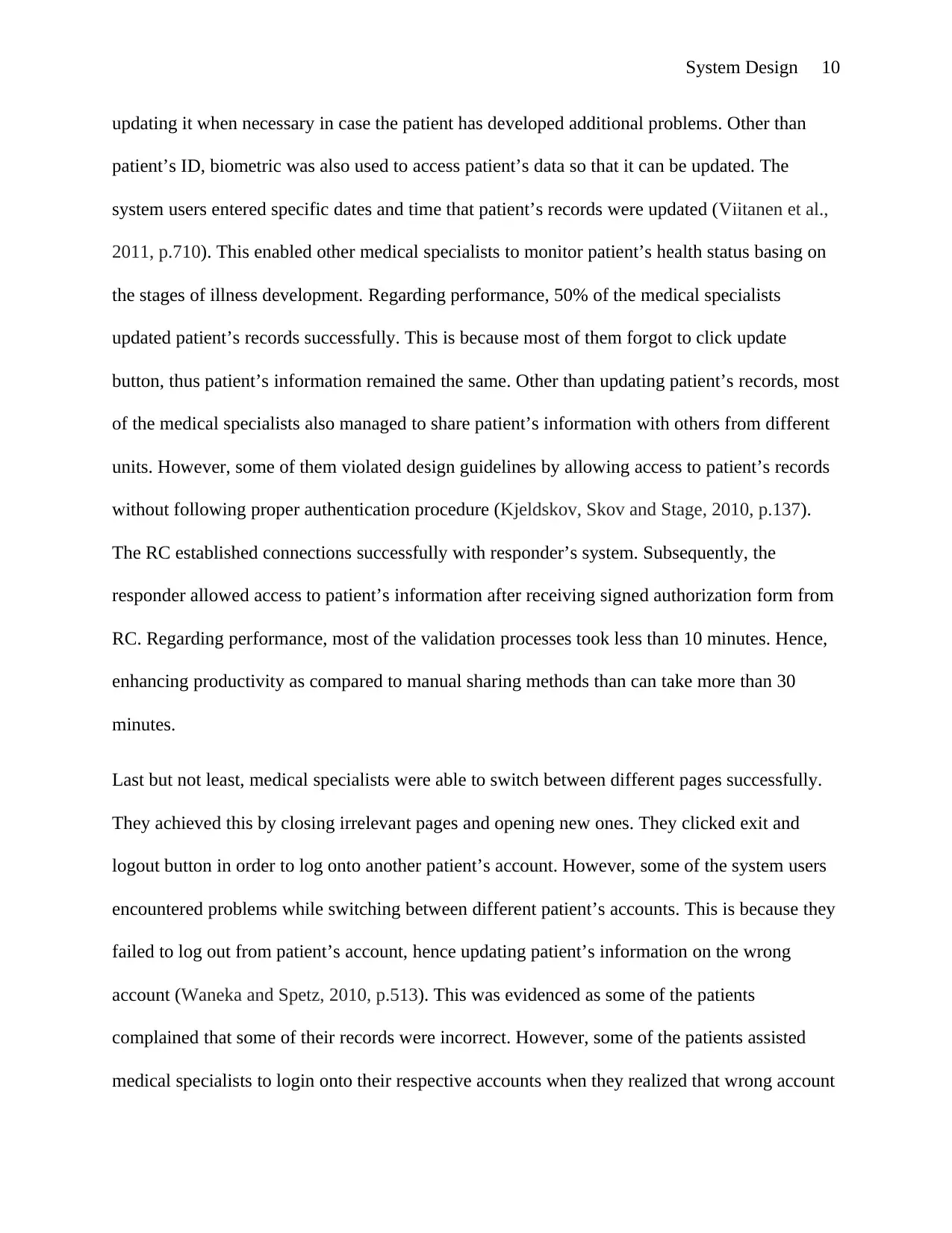
System Design 10
updating it when necessary in case the patient has developed additional problems. Other than
patient’s ID, biometric was also used to access patient’s data so that it can be updated. The
system users entered specific dates and time that patient’s records were updated (Viitanen et al.,
2011, p.710). This enabled other medical specialists to monitor patient’s health status basing on
the stages of illness development. Regarding performance, 50% of the medical specialists
updated patient’s records successfully. This is because most of them forgot to click update
button, thus patient’s information remained the same. Other than updating patient’s records, most
of the medical specialists also managed to share patient’s information with others from different
units. However, some of them violated design guidelines by allowing access to patient’s records
without following proper authentication procedure (Kjeldskov, Skov and Stage, 2010, p.137).
The RC established connections successfully with responder’s system. Subsequently, the
responder allowed access to patient’s information after receiving signed authorization form from
RC. Regarding performance, most of the validation processes took less than 10 minutes. Hence,
enhancing productivity as compared to manual sharing methods than can take more than 30
minutes.
Last but not least, medical specialists were able to switch between different pages successfully.
They achieved this by closing irrelevant pages and opening new ones. They clicked exit and
logout button in order to log onto another patient’s account. However, some of the system users
encountered problems while switching between different patient’s accounts. This is because they
failed to log out from patient’s account, hence updating patient’s information on the wrong
account (Waneka and Spetz, 2010, p.513). This was evidenced as some of the patients
complained that some of their records were incorrect. However, some of the patients assisted
medical specialists to login onto their respective accounts when they realized that wrong account
updating it when necessary in case the patient has developed additional problems. Other than
patient’s ID, biometric was also used to access patient’s data so that it can be updated. The
system users entered specific dates and time that patient’s records were updated (Viitanen et al.,
2011, p.710). This enabled other medical specialists to monitor patient’s health status basing on
the stages of illness development. Regarding performance, 50% of the medical specialists
updated patient’s records successfully. This is because most of them forgot to click update
button, thus patient’s information remained the same. Other than updating patient’s records, most
of the medical specialists also managed to share patient’s information with others from different
units. However, some of them violated design guidelines by allowing access to patient’s records
without following proper authentication procedure (Kjeldskov, Skov and Stage, 2010, p.137).
The RC established connections successfully with responder’s system. Subsequently, the
responder allowed access to patient’s information after receiving signed authorization form from
RC. Regarding performance, most of the validation processes took less than 10 minutes. Hence,
enhancing productivity as compared to manual sharing methods than can take more than 30
minutes.
Last but not least, medical specialists were able to switch between different pages successfully.
They achieved this by closing irrelevant pages and opening new ones. They clicked exit and
logout button in order to log onto another patient’s account. However, some of the system users
encountered problems while switching between different patient’s accounts. This is because they
failed to log out from patient’s account, hence updating patient’s information on the wrong
account (Waneka and Spetz, 2010, p.513). This was evidenced as some of the patients
complained that some of their records were incorrect. However, some of the patients assisted
medical specialists to login onto their respective accounts when they realized that wrong account
Paraphrase This Document
Need a fresh take? Get an instant paraphrase of this document with our AI Paraphraser
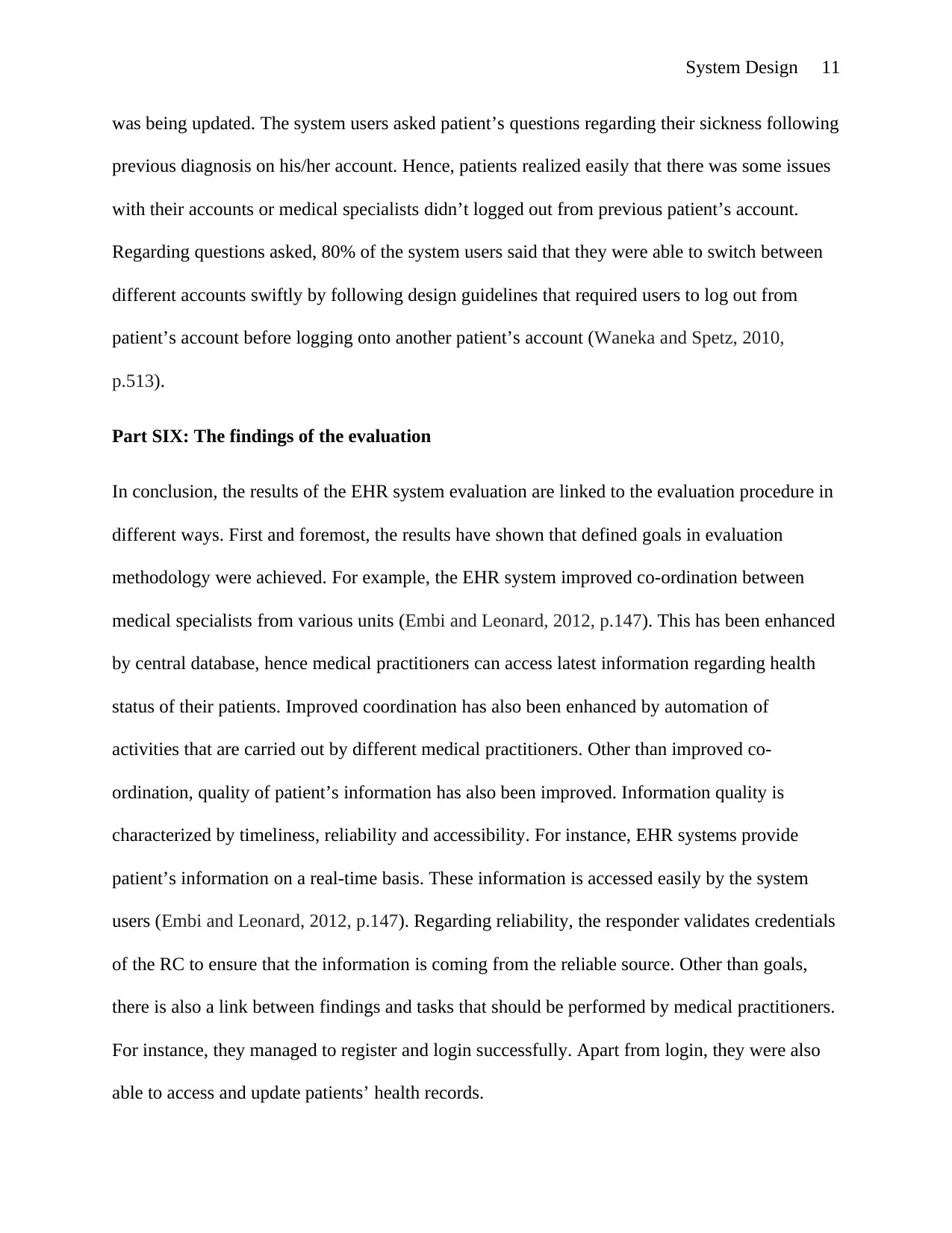
System Design 11
was being updated. The system users asked patient’s questions regarding their sickness following
previous diagnosis on his/her account. Hence, patients realized easily that there was some issues
with their accounts or medical specialists didn’t logged out from previous patient’s account.
Regarding questions asked, 80% of the system users said that they were able to switch between
different accounts swiftly by following design guidelines that required users to log out from
patient’s account before logging onto another patient’s account (Waneka and Spetz, 2010,
p.513).
Part SIX: The findings of the evaluation
In conclusion, the results of the EHR system evaluation are linked to the evaluation procedure in
different ways. First and foremost, the results have shown that defined goals in evaluation
methodology were achieved. For example, the EHR system improved co-ordination between
medical specialists from various units (Embi and Leonard, 2012, p.147). This has been enhanced
by central database, hence medical practitioners can access latest information regarding health
status of their patients. Improved coordination has also been enhanced by automation of
activities that are carried out by different medical practitioners. Other than improved co-
ordination, quality of patient’s information has also been improved. Information quality is
characterized by timeliness, reliability and accessibility. For instance, EHR systems provide
patient’s information on a real-time basis. These information is accessed easily by the system
users (Embi and Leonard, 2012, p.147). Regarding reliability, the responder validates credentials
of the RC to ensure that the information is coming from the reliable source. Other than goals,
there is also a link between findings and tasks that should be performed by medical practitioners.
For instance, they managed to register and login successfully. Apart from login, they were also
able to access and update patients’ health records.
was being updated. The system users asked patient’s questions regarding their sickness following
previous diagnosis on his/her account. Hence, patients realized easily that there was some issues
with their accounts or medical specialists didn’t logged out from previous patient’s account.
Regarding questions asked, 80% of the system users said that they were able to switch between
different accounts swiftly by following design guidelines that required users to log out from
patient’s account before logging onto another patient’s account (Waneka and Spetz, 2010,
p.513).
Part SIX: The findings of the evaluation
In conclusion, the results of the EHR system evaluation are linked to the evaluation procedure in
different ways. First and foremost, the results have shown that defined goals in evaluation
methodology were achieved. For example, the EHR system improved co-ordination between
medical specialists from various units (Embi and Leonard, 2012, p.147). This has been enhanced
by central database, hence medical practitioners can access latest information regarding health
status of their patients. Improved coordination has also been enhanced by automation of
activities that are carried out by different medical practitioners. Other than improved co-
ordination, quality of patient’s information has also been improved. Information quality is
characterized by timeliness, reliability and accessibility. For instance, EHR systems provide
patient’s information on a real-time basis. These information is accessed easily by the system
users (Embi and Leonard, 2012, p.147). Regarding reliability, the responder validates credentials
of the RC to ensure that the information is coming from the reliable source. Other than goals,
there is also a link between findings and tasks that should be performed by medical practitioners.
For instance, they managed to register and login successfully. Apart from login, they were also
able to access and update patients’ health records.
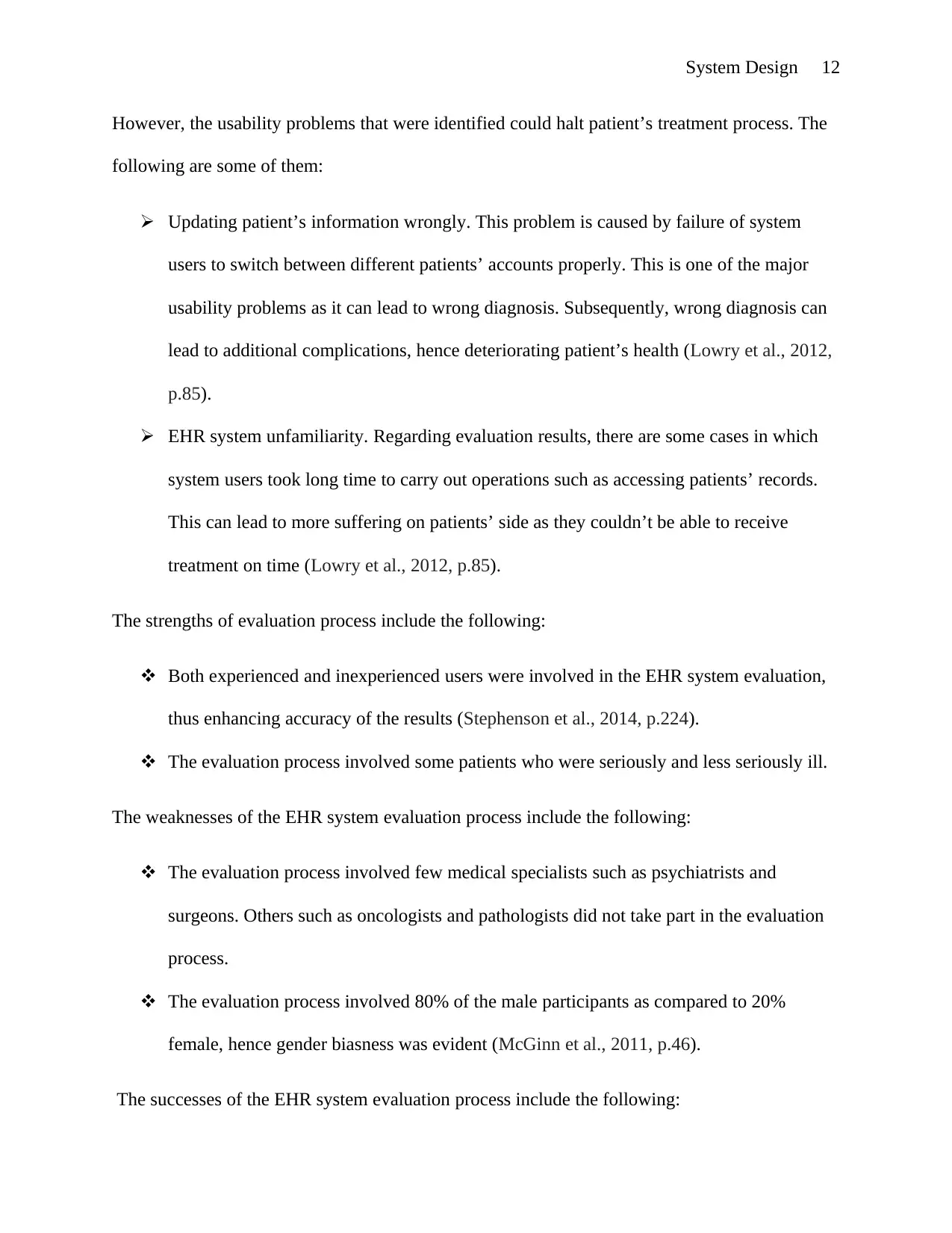
System Design 12
However, the usability problems that were identified could halt patient’s treatment process. The
following are some of them:
Updating patient’s information wrongly. This problem is caused by failure of system
users to switch between different patients’ accounts properly. This is one of the major
usability problems as it can lead to wrong diagnosis. Subsequently, wrong diagnosis can
lead to additional complications, hence deteriorating patient’s health (Lowry et al., 2012,
p.85).
EHR system unfamiliarity. Regarding evaluation results, there are some cases in which
system users took long time to carry out operations such as accessing patients’ records.
This can lead to more suffering on patients’ side as they couldn’t be able to receive
treatment on time (Lowry et al., 2012, p.85).
The strengths of evaluation process include the following:
Both experienced and inexperienced users were involved in the EHR system evaluation,
thus enhancing accuracy of the results (Stephenson et al., 2014, p.224).
The evaluation process involved some patients who were seriously and less seriously ill.
The weaknesses of the EHR system evaluation process include the following:
The evaluation process involved few medical specialists such as psychiatrists and
surgeons. Others such as oncologists and pathologists did not take part in the evaluation
process.
The evaluation process involved 80% of the male participants as compared to 20%
female, hence gender biasness was evident (McGinn et al., 2011, p.46).
The successes of the EHR system evaluation process include the following:
However, the usability problems that were identified could halt patient’s treatment process. The
following are some of them:
Updating patient’s information wrongly. This problem is caused by failure of system
users to switch between different patients’ accounts properly. This is one of the major
usability problems as it can lead to wrong diagnosis. Subsequently, wrong diagnosis can
lead to additional complications, hence deteriorating patient’s health (Lowry et al., 2012,
p.85).
EHR system unfamiliarity. Regarding evaluation results, there are some cases in which
system users took long time to carry out operations such as accessing patients’ records.
This can lead to more suffering on patients’ side as they couldn’t be able to receive
treatment on time (Lowry et al., 2012, p.85).
The strengths of evaluation process include the following:
Both experienced and inexperienced users were involved in the EHR system evaluation,
thus enhancing accuracy of the results (Stephenson et al., 2014, p.224).
The evaluation process involved some patients who were seriously and less seriously ill.
The weaknesses of the EHR system evaluation process include the following:
The evaluation process involved few medical specialists such as psychiatrists and
surgeons. Others such as oncologists and pathologists did not take part in the evaluation
process.
The evaluation process involved 80% of the male participants as compared to 20%
female, hence gender biasness was evident (McGinn et al., 2011, p.46).
The successes of the EHR system evaluation process include the following:
⊘ This is a preview!⊘
Do you want full access?
Subscribe today to unlock all pages.

Trusted by 1+ million students worldwide
1 out of 19
Related Documents
Your All-in-One AI-Powered Toolkit for Academic Success.
+13062052269
info@desklib.com
Available 24*7 on WhatsApp / Email
![[object Object]](/_next/static/media/star-bottom.7253800d.svg)
Unlock your academic potential
Copyright © 2020–2025 A2Z Services. All Rights Reserved. Developed and managed by ZUCOL.





